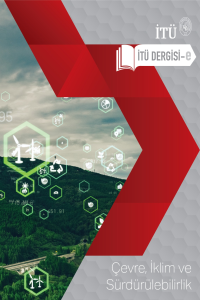Streptomisinin anaerobik perdeli reaktör de arıtımı ve toksisite giderimi
Aerobik sürekli karıştırmalı tank reaktör(SKTR), anaerobik perdeli reaktör (APR), Daphnia magna (su piresi), streptomisin ve toksisite
___
- Anderson, G. K. ve Yang, G., (1992). Determination of bicarbonate and total volatile acid concentration in anaerobic digesters using a simple titration, Water Environment Research, 64, 53-59.
- APHA-AWWA, (1992). Standard methods for the Examination of Water and Wastewater, 17 th edition, American Public Health Association/American Water Works Association/Water Environment Federation, Washington DC, USA.
- Behling, E., Diaz, A., Colina, G., Herrera, M., Gutierrez, E. ve Chacin, E., (1997). Domestic wastewater treatment using a UASB reactor, Bioresource Technology, 61, 239-245.
- Beydilli, M.I, Pavlosathis, S.G. ve Tincher, W.C., (1998). Decolorization and toxicity screening of selected reactive azo dyes under methanogenic conditions, Water Science and Technology, 38, 225-32.
- Dhawan, S., Lal, R., Hanspal, M. ve Kuhad, R.C., (2005). Effect of antibiotics on growth and laccase production from Cyathus bulleri and Pycnoporus cinnabarinus, Bıoresource Technology, 96, 1415-1418.
- Huajun, F., Lifang, H., Dan, S., Chengran, F., Yonghua, H. ve Dongsheng, S., (2008) Effects of temperature and hydraulic residence time (HRT) on treatment of dilute wastewater in a carrier an-aerobic baffled reactor, Biomedical and Environmental Sciences, 21, 460-466.
- Kemper, N., (2008). Veterianry antibiotics in the aquatic and terrestrial environment, Ecological Indicators, 8, 1-13.
- Kurosawa, N., Kuribayashi, S., Owada, E., Ito, K., Nioka, M., Arakawa, M. ve Fukuda, R.J., (1985).
- HPLC Application note, Journal of Chromatography 343, 44, 379-385.
- Mitic, S.S., Sunaric, S.M. ve Tosic ,S.B., (2006). Determination of streptomycin in a pharmaceutical sample based on its degradation by hydrogen peroxide in the presence of copper(II), Analytical Scıences, 22, 753-757.
- Oktem, Y., Ince, O., Sallis, P., Donnelly, T. ve Ince, K.B., (2007). Anaerobic treatment of a chemical synthesis- based pharmaceutical wastewater in a hybrid upflow anaerobic sludge blanket reactor, Bioresource Technology, 99, 1089-1096.
- Razo-Flores, E., Luijten, M., Donlon, B.A., Lettinga, G. ve Field, J.A., (1997). Biodegradation of selected azo dye under methanogenic conditions, Water Science Technology, 36, 65-72.
- Speece, R.E., (1996). Anaerobic biotechnology for industrial wastewater, Tennessee: Archae Press, 5840 R.E. Lee, Dr. Nashville, 37215.
- Swartzman, G., Rosec, K., Kindigd, A. ve Taubb, F., (1989). Modeling the direct and indirect effects of streptomycin in aquatic microcosms, Aquatic Toxicology, 14, 109-129.
- Uludağ, N. Retrieved August 8, 2009, http://kbb.uludag.edu.tr /antibiyotik05.htm
- Yayın Aralığı: Yılda 2 Sayı
- Başlangıç: 2022
- Yayıncı: İstanbul Teknik Üniversitesi
Streptomisinin anaerobik perdeli reaktör de arıtımı ve toksisite giderimi
Seçil TÜZÜN, Delia Teresa SPONZA
Farklı filtre malzemeleri için temiz yatak yük kayıplarının belirlenmesi
Esra ERDİM, İbrahim DEMİR, Ömer AKGİRAY
Stabilize arıtma çamurlarının topraktaki azot ve üreaz aktivitesine etkileri
Efsun DİNDAR, F.olcay TOPAÇ ŞAĞBAN, Hüseyin S. BAŞKAYA
Pelin Ongan TORUNOĞLU, Derin ORHON
Olcay TÜNAY, Emine METİN, Işık KABDAŞLI, Tuğba ÖLMEZ-HANCI
Kağıt endüstrisi atıksu arıtma tesislerinde çamur işleme ünitelerinin toplam maliyete etkisi
Emre KÖKEN, Nurdan BÜYÜKKAMACI
İçme suyundan kimyasal yöntemlerle arsenik giderimi
M. Necdet ALPASLAN, Deniz DÖLGEN, Hülya BOYACIOĞLU, Hasan SARPTAŞ
Kentsel nitelikli arıtma çamurlarının ultrasonik yöntemle ön arıtımı
Sünger filtre ile çamur yoğunlaştırma
Kesikli ozonlama yöntemi ile atık çamur azaltımı
Melis MUZ, M. Selcen SÖNMEZ, Okan T. KOMESLİ, Celal F. GÖKÇAY
